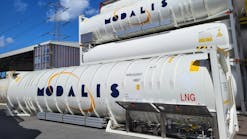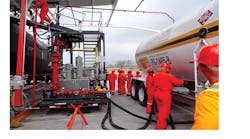Ambient temperature and existing infrastructure among critical factors for safely transloading LPG, butane from railcar to truck
SKY Eye Measurement, founded in 2005 in Acheson, Alberta, Canada, is growing into a leader in liquified petroleum gas (LPG) and butane transloading, building a successful business on the fundamentals of safety, performance and reliability.
The key, said John Forchuk, Sky Eye’s vice-president of business development, is to recognize the various challenges associated with moving LPG and butane from railcar to truck, including distance, weather and infrastructure, and then providing a versatile array of solutions to meet those challenges.
“In each scenario, whether we go from a brownfield facility to a new-venture rail spur that’s going to be there for six to 12 months, understanding the different mechanisms and properties of that fluid and how it wants to act, and the gasses, will start to guide us in what direction we go for a solution,” Forchuk said.
Forchuk touched on approaches to transloading his company deploys, including using drive gasses, pumps and compressors, and the importance of engineering safety into transloaders, in the “Advancements in transloading LPG and butane” session at the International Liquid Terminal Association’s 38th Annual International Operating Conference & Trade Show in Houston, Texas.
Multiple techniques
Sky Eye, which bills itself as a hydrocarbon transfer and measurements solutions specialist, uses different utility “drive” gasses, such as nitrogen and natural gas, to pressurize and sweep rail cars for liquid butane and propane, depending on capital cost vs. application, and an operation’s complexity.
In exploratory ventures, like moving product in emerging markets in Mexico, or in others where capital’s deployed to understand the business, portable hydraulic techniques are effective solutions.
In these situations, Sky Eye might deploy an intermediate component with generation, with the goal of moving product quickly.
“If the rail cars are stopping, we can bring in that infrastructure with power to perform these types of transfers,” Forchuk said.
As businesses and their associated projects grow, the company can utilize bullet tanks to assist in transfers.
“Each client has different situations, whether it’s distances and locations of equipment, and what sort of technologies or solutions will suffice,” Forchuk said. “We’ve used a combination of straight-up hydraulic … where you do have the interim bullets and the smaller compression to move that product to and from, and then you might be moving a liquid through the pumps to the trucks.”
At another site, Sky Eye used a combination of manifest transloading, and permanent bullets and compression, with a liquid end for pumping to trucks.
A hydraulic transfer method, which is relevant to fully independent situations, can draw on shared vapor capacity.
“Say you’ve got a truck under zero pressure and the rail car is being received with some pressure, and you’re going to try to move that liquid volume over to that truck with zero pressure on it,” Forchuk said. “Through the hydraulic method with LPG, the free vapor available is the drive gas.
“The compressor uses it to feed the system, we generate the pressure differential and then we hydraulic that liquid over to the truck.”
Varying conditions
Propane will have free gas available throughout the temperature envelope.
But transloading butane in cooler temperatures often presents a problem, with butane in near-freezing conditions providing no free gas, so Sky Eye combined a pumping system with a compressor.
“What that allowed us to do is, throughout the temperature envelope of the day, on, say, very flat butane in a car with literally zero pressure on it, we would move that at the beginning of the transfer with the pump,” Forchuk said. “Now, if the ambient temperature effects allowed free gas to come, we would use the compressor to assist that pumping system, and they would work in unison.”
Higher temperatures create different challenges.
Forchuk said compressors tend to overheat in certain propane transloading applications in a vapor recovery state.
“For us, we lean toward maximizing the compressor displacement, so that if we are going to be running that system, we’re going to have maximum effect on those vapors coming over,” he said. “We felt it was quite successful to be able to empty those rail cars in the 40-45 degrees Celsius (104-113 degrees Fahrenheit) regions of Mexico in short order, while not sacrificing volume in the rail car.”
Using a butane vaporizer is another transloading technique, especially at larger facilities with long vapor lines, where companies are dealing with condensation or liquid dropouts, but it isn’t as effective in smaller manifest situations with limited capacity, capital and infrastructure, Forchuk said.
In these situations, or where existing facilities can’t generate enough pressure to move butane, Sky Eye found another solution.
“We provided a low-pressure system with a surge drum recycling the vapor space off that surge drum through compression, and feeding that low-pressure bullet with a pump,” Forchuk said.
Regardless of the unique challenges they’re facing, or the specific techniques deployed, safety comes first, Forchuk said.
Safety first
Sky Eye leans on regulations for managing risk in mature spaces, but in manifest transloading with portable units, the company prefers to engineer risk out of the equipment, adding safety control systems with “layers of protection,” including isolation, automation and alarming for operational personnel.
One example is a piping system that accommodates thermal expansion with a chamber for relieving pressure.
The risk of ignition is well-known and well-regulated in the industry.
Still, the company double downs with features like LEL (Lower Explosive Limit) and UV/IR detection connected through the local transfer safety system, putting sophistication into the solution.
“That, in combination with some fire suppression at some of these smaller facilities, allowed our operators to get acceptance on their applications and licensing, where even from a regulatory perspective, in some markets, they’re still emerging, as is their understanding of safety,” Forchuk said.
Sky Eye’s transloaders also incorporate HMI, or Human Machine Interface, controls that present information, such as pressure, temperature and flow, to an operator, and implement the operator’s instructions.
“By introducing this level of sophistication, their net benefit, first, is from a safety standpoint, in stopping the event prior to, but then also informing the operations group on what the issues are,” Forchuk said.
Other safety commitments include trailer and gantry designs with OSHA-approved hand rails, hoops and guards, the use of electric engines in certain hazardous zones, and breakaway “smart” hoses.
“Applying a little bit of technology and investing in engineering forethought has a net benefit from a performance, safety and reliability standpoint,” Forchuk said.














